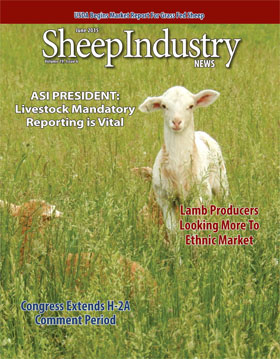
- June 2015
- President’s Notes
- Congress Extends H-2A Period
- Theos Family Reaching Niche Lamb Market
- Market Report
- Australian Wool Market Rallied; U.S. Gains
- USDA Begins Releasing Grass Fed Report
- Clark Willis Obituary
- Region IV Bighorn Plan Implemented in Utah
- Western Lawmakers Team to De-List Wolves
- ASI Photo Contest
- ASI Supports COOL For Lamb
- Battle Not Over in Sage Grouse Fight
- Livestock Mandatory Reporting
- No Grazing This Summer
- Separate Efforts: Scrapie Eradication Program and the Animal Disease Traceability Program
- Lamb Producers Look to Ethnic Groups
- Study Explores Disease in Grand Canyon Bighorns
- Sheep News In Brief
Region IV Bighorn Plan Implemented in Utah
The bighorn management framework of Region 4 of the U.S. Forest Service (USFS) is now being implemented in Utah.
Utah sheep producers have been informed of the agency’s decision to close and reduce sheep grazing allotments by 2017 due to bighorn management.
The consequences of the forest service’s decision for the ranchers will range from a complete loss of two allotments and drastically reduced grazing days on additional allotments to the loss of other allotments due to “risk of contact” between domestic and bighorn sheep.
According to ASI Executive Director Peter Orwick, “The forest service announced last year that they were implementing a plan for bighorn sheep that was developed in cooperation with the Western Watersheds Project, an anti-livestock grazing group.”
The plan removes domestic sheep from grazing allotments to keep the two species – domestic and bighorn sheep – separate. The “occupied bighorn habitat” impacts 7 percent to 10 percent of the nation’s domestic sheep. In “potential habitat,” over 20 percent of the industry is threatened. Idaho, Nevada and Wyoming are in Region 4 of USFS along with Utah.
“As feared, the agency announced closure of grazing with no offer of alternative grazing for the sheep rancher,” said Orwick. “Western sheep ranches were built decades ago on the basis of high country grazing in the summer and, if these allotments are not replaced, where do they go with thousands of ewes and lambs? Under a similar scenario on the Payette Forest in Idaho several years ago, thousands of animals were sold and ranches went out of business.”
Fortunately, there is an option to direct the agency to work with the ranchers and provide alternative country to replace grazing lost to the bighorn plan.
“We have bill and report language before the U.S. Congress to require suitable alternative allotments for sheep operators whose permits in bighorn habitat are subject to being reduced as well as requiring the use of sound science as criteria in the decision process,” concluded Orwick.
The Congressional appropriations process is in full swing through early June. ASI has reminded producers that it is essential for state associations and producer leaders to contact their congressmen to ensure the industry’s bighorn language is included in the House Interior Appropriation Subcommittee’s mark-up for fiscal year 2016. The bill and report language is available at www.sheepusa.org by clicking on the Legislative Action Center on the ASI website.
Bighorn Letters Update
Thirty-six members of the U.S. Senate and the U.S. House of Representatives wrote to Secretary of Agriculture Tom Vilsack and Department of Labor Secretary Sally Jewell regarding sheep grazing and wild sheep management.
Congress first raised questions and concerns federal-land management that would reduce sheep grazing in June of 2014. Leaders acknowledged the administration’s responses, however, noted that multiple questions and concerns were not addressed and there continues to be a general lack of clarity on the issue. The U.S. Forest Service in particular needs to hold the necessary public forums to present maps of presumed risk areas, levels of acceptable risk, discussion of how these areas were identified and options available to eliminate those risks.
A key request of the Forest Service was for it to confirm that it does not need a mandate to manage for zero risk when looking at species viability.
Another key topic raised by congressional leaders was the lack of collaboration with the Agricultural Research Service. The responses to the 2014 Congressional inquiry did not reference working with ARS in spite of the fact that Congress specified collaboration between the agencies on livestock and wildlife.

